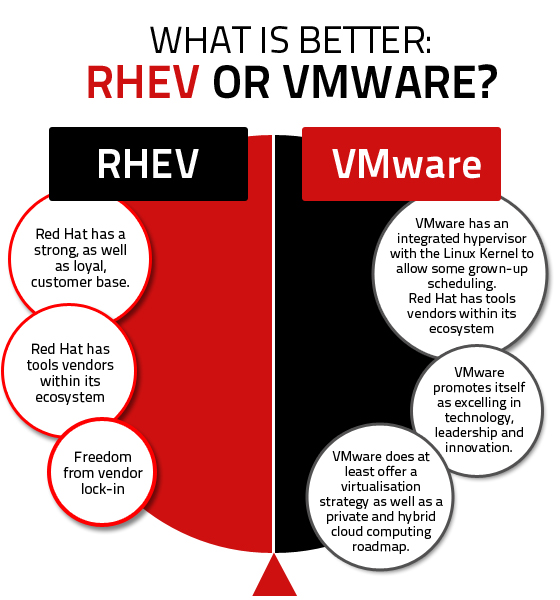This article discusses why organisations virtualise their server environments, Cloud and whether Red Hat Enterprise Virtualization (RHEV) or VMware is the best option.

Organisations virtualise their server environments to rationalise costs and server space in their data centres. Costs can be reduced by opting for virtualised desktop and storage solutions too, and virtualisation doesn’t have to be about Cloud computing – although that is one way it’s used.
Virtualisation: a step forward
Open Source consultancy LinuxIT’s Mike Curtis, Executive Director – Service Delivery, says that organisations should consider questions like: “To what extent do server, desktop and storage virtualisation rely on Linux systems?” The key thing is to think about what you are using virtualisation for and the costs associated with hardware and power usage.
Virtualisation is a step towards the utilisation of Cloud, where you pay for what you use based on a utility model. It also offers a means to consolidate the number of servers used, and this can reduce power consumption and thus save money. With this comes the bonus of being able to achieve flexibility around Disaster Recovery (DR).
What is better: RHEV or VMware?
Red Hat’s RHEV and VMware both have strengths and weaknesses.
Red Hat has a strong, as well as loyal, customer base. Most virtualised Red Hat Enterprise Linux (RHEL) instances are found in VMware, but it lacks tools vendors within its ecosystem. However, it does have an integrated hypervisor with the Linux Kernel to allow some grown-up scheduling.
VMware promotes itself as excelling in technology, leadership and innovation. While some customers are concerned about vendor lock-in, VMware does at least offer a virtualisation strategy as well as a private and hybrid cloud computing roadmap. Given all of this, it’s important to speak with an Open Source specialist so that they can carry out an independent assessment of which system suits your organisation’s needs the most.
How does Cloud fit in?
Cloud fits into the picture in solutions like Gmail, Dropbox, Salesforce and other applications. “If the applications are supported by the product set you have selected you should be able to move to application Cloud in the future because you don’t have to homogenise at hypervisor level – CIOs like this”, says Curtis.
Can other operating systems and applications be used in virtualisation?
Curtis says they can; but they are “just more expensive, and if you use Windows you still have to buy licences”. However, there are some applications that just aren’t supported by some virtualised environments. So it’s worth checking to see whether your organisation’s applications are suitable for them. Oracle applications and databases, for example, are only supported within Oracle VM. It could work though.
Why should I use a virtualised Linux platform over any other?
Because the hypervisor is not application aware. The right Open Source software specialist can help you by examining all of the options to find out whether RHEV, Oracle VM, VMware or other solutions are right for your business.
“As a Linux systems management specialist, we audit your requirements without bias and with vendor neutrality to ensure that the correct system blends in”, concludes Curtis. The benefits include a reduction in the total cost of ownership, which occurs when data centres migrate to Open Source, creating a better return on investment.

